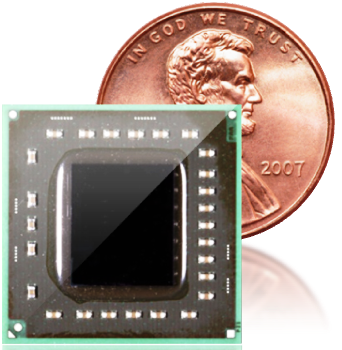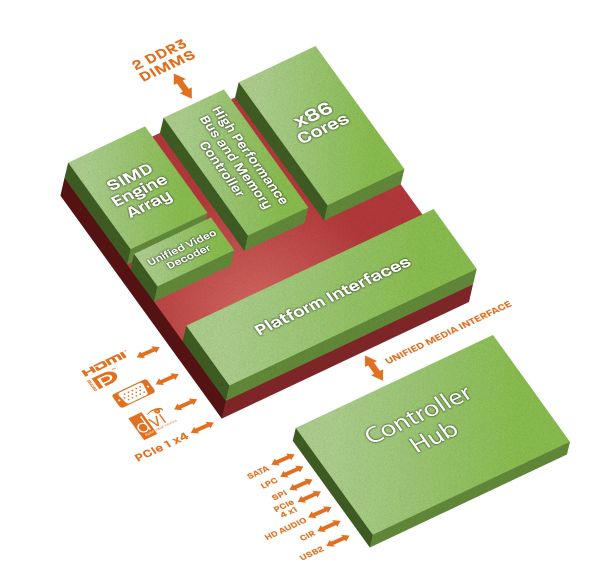AMD G-Series Brings APUs to the x86 Embedded Market
by Ganesh T S on January 19, 2011 12:29 AM ESTThe embedded market is huge and growing, and needs innovative, complete system platforms. These systems are compute intensive and have high performance graphics requirements, which make the embedded market a key part of AMD's strategy to drive revenue growth. There is an ongoing push for decreased power, smaller size and higher capability systems at lower price points. The strong visual element and growing need for quality graphics in many embedded markets such as set top boxes make it the ideal time for the AMD APU to get introduced into this space.

AMD's solutions (integrated CPU + GPU) are ideal for thin clients, medical imaging, point of sale and kiosk systems, gaming machines, digital signage and single board computing systems. These APUs integrate a multi-core CPU and a GPU sub-system on the same die to give a general-purpose, programmable scalar and vector processor core with heterogeneous capabilities.
The AMD Embedded G-Series Platform consists of an APU and a Fusion Controller Hub. The features are as below:
APU
- 2 x86 CPU Cores (40nm “Bobcat” core – 1 MB L2, 64-bit FPU)
- C6 and power gating
- Array of SIMD Engines [ DX11 graphics performance, Industry leading 3D and graphics processing ]
- 3rd Generation Unified Video Decoder [ H.264, VC1, DivX/Xvid ]
- DDR3 800-1066, 2 DIMMs, 64 bit channel
- BGA package
AMD Fusion Controller Hub for display and I/O
- Two dedicated digital display interfaces [ Configurable externally as HDMI, DVI, and/or Display Port, and as single link LVDS for internal panels ]
- Integrated VGA
- 5x8 PCIe®
- “Hudson” Fusion Controller Hub
With the introduction of the G-Series, AMD is showing a strong commitment to the x86 embedded market. AMD claims that it is the world's first and only APU for embedded systems. AMD Fusion can bring a new generation of differentiated, small form factor embedded systems that consume less power, yet deliver improved performance and features. The GPU component can deliver an outstanding visual experience compared to other x86 based embedded systems.
We are reproducing the different SKUs available for the APU as well as the platform controller hub (PCH) from AMD's official site below (click to enlarge):
Given ATI's strong GPU background, there is no doubt that the graphics in the G-Series will turn out to be much better than the embedded solution from Intel and VIA. However, we do have some concerns about the capability of the UVD engine in the platform. While the marketing slides indicated that Blu-Ray titles can be smoothly played back, it also had another entry indicating that 1080p video playback support availability was only in the 18W processors and higher. We were also not provided with the difference between the embedded G-Series and the desktop Brazos platform that Anand had covered earlier. It looks likely that the GPU capabilities (SIMD engine) are not the same, with the embedded solution having half the number of stream processors. However, we are awaiting confirmation on this. Expect an update in this section as soon as we hear back from AMD.













76 Comments
View All Comments
semo - Wednesday, January 19, 2011 - link
I think that Intel use the term to describe CPUs with extended support too. Yep, lost all meaning as far as I'm concernedint9 - Wednesday, January 19, 2011 - link
The T40N and the T44R are 9W but substantially weaker. This seems like another blow against Atom. I can't wait to see what that GPU will do.silverblue - Wednesday, January 19, 2011 - link
"This new "class" of CPU's are nothing more than downscaled desktop counterparts."But... it's the same as the desktop equivalent.
I agree with the idea that it's hungrier than it should be for this sort of thing, however please bear in mind that it's not going to be drawing 18W constantly. Power gating and downclocking should ensure a far lower average usage.
ninjaquick - Wednesday, January 19, 2011 - link
Embedded is a form-factor matter. An embedded solution can also be a slave system. An example of embedded use for this would be automotive interface computers, like built in GPS or Media Players. Embedded basically means it is not used as a traditional computer.driscoll42 - Wednesday, January 19, 2011 - link
After reading the comments I wanted to just say that there are some of us who did appreciate the article. I understand that you don't have a whole lot to go off of other than the Press Release so expecting many more details is a bit far fetched. I prefer some context to a Press Release as opposed to just the PR itself. As a student just starting a Computer Architecture course it's always exciting to what's new in the world, especially in embedded since that's the focus of the course. Anyways, thanks for the article, I look forward to reading more.digitalzombie - Wednesday, January 19, 2011 - link
Article seems to lean toward AMD because of all the AMD's supplied pictures and you're talking about the potential of AMD's embedded product. I would like to point out that you did state negatives for AMD's in the embedded market. Just fyi on why people might think this is an AMD's PR. There is probably nothing you can do, other than maybe photoshop some funny cute cat pictures with AMD on it.How come AMD and Intel are so behind in the embedded market? Is it because of their lack of interest until now and their non-existing technologies for low power chip? Their lack of IP's in technologies such as FPGA or whatever fancy do hicky? Is it because building cpu for the embedded systems require a different set of skills that AMD and Intel aren't well verse as ARM and MIPS? I guess, I don't understand how these major CPU company AMD and Intel cannot compete or beat ARM and MIPS. All they do is make CPU, well they're doing GPU now I guess, how can they not beat these smaller companies? Is the x86 ISA are too complex for embedded system? Doesn't make sense, I guess, since MIPS have 64bit.
silverblue - Wednesday, January 19, 2011 - link
That's almost like asking "why can't ARM and MIPs compete with Intel and AMD in the desktop space?". I don't know... that's just the way I see it.If these are the same as the other Fusion processors, they'll fully support the x86-64 architecture. Oddly enough, they also support AMD-V... :)
Sufo - Wednesday, January 19, 2011 - link
"why can't ARM and MIPs compete with Intel and AMD in the desktop space?"They can, and will. As has been reported even on this site, windows 8 will supposedly support ARM architecture. Time to buy ARM stock is now (well, ok, it was 18 months - 2 years ago, but still...).
ninjaquick - Wednesday, January 19, 2011 - link
ARM designs are not anywhere complex or large enough to run against big die processors. ARM is a good foundation but they do not have any designs that can compete with Nehalem or Stars. I would love to ARM's take on mainstream computing, and its support in Windows 8 is exciting to say the least.LiquidLearner - Wednesday, January 19, 2011 - link
Perhaps current ARM designs aren't, but remember that ARM is a RISC based processor. The reason Macs used to be so much better at Photoshop and movie editing was because RISC is a more efficient architecture than x86. That's ultimately why they are able to use less power now, each instruction is less work than it is on x86. At least that seems to be my vague memory from classes 10 years ago. It was something one of the professors would complain about on a regular basis.If you have Windows 8 running on ARM and it is highly optimized for multi-core you could stack 16 Snapdragon cores (for example) into a single cpu and still use less power than most desktop CPUs currently use. All of these running at 1.5-2Ghz. That's an awful lot of processing power. This assumes that Windows 8 will be highly scalable to multiple cores which is likely a good assumption.